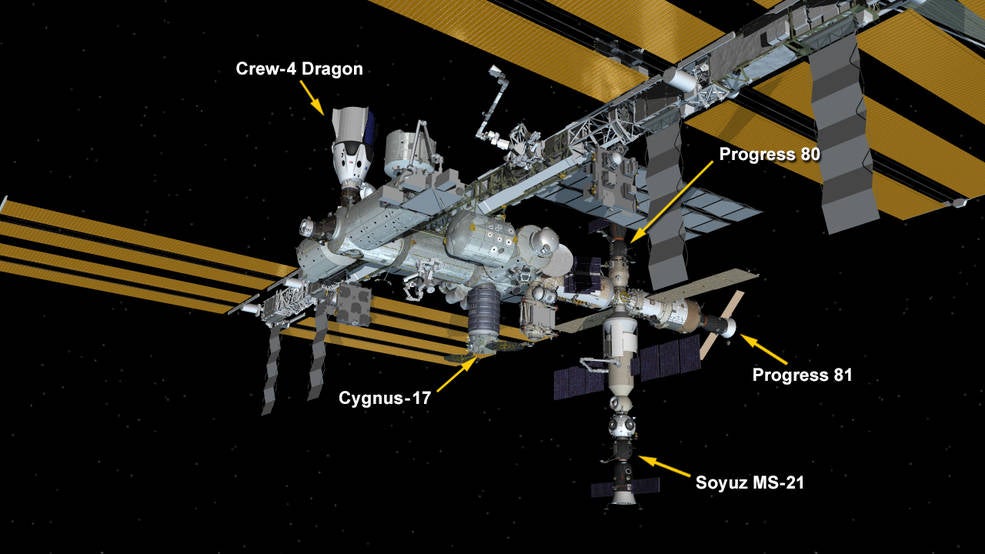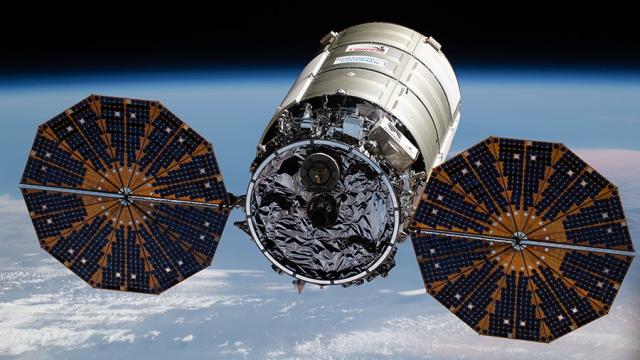NASA is currently evaluating the ability of docked Cygnus spacecraft to serve as boosters for the International Space Station, but a recent test of the concept was quickly stopped, for reasons that aren’t yet clear.
The engine firing of Northrop Grumman’s Cygnus NG CRS-17 spacecraft began at 11:20 a.m. ET on Monday, June 20, and it was supposed to last for exactly 5 minutes and 1 second, but NASA called the whole thing off after just 5 seconds, according to an agency press release. Officials with the Cygnus mission said “the cause for the abort is understood and under review,” NASA added, but without providing any more detail. In an email to Gizmodo, a NASA spokesperson said the agency will provide more updates on its space station blog later this week.
The purpose of the test was to evaluate the ability of docked Cygnus spacecraft to serve as functional ISS boosters. The space station is equipped with its own propulsion system, but it’s often inadequate for making major positional adjustments. The ISS, in orbit some 418 km above the surface, occasionally needs to move, whether for operational reasons or when having to dodge other satellites or potentially dangerous space debris.

Such was the case just a few days ago. On June 16, a docked Russian Progress 81 spacecraft fired its thrusters for 4 minutes and 34 seconds, in a procedure that provided extra distance from the predicted track of space debris, namely a fragment from the former Russian satellite Cosmos 1408, which Russia deliberately destroyed earlier this year in a brazen anti-satellite weapons test. The crew was apparently “never in any danger,” but without the orbital adjustment, “it was predicted that the fragment could have passed within around a half mile from the station,” according to a NASA press release.
With so many satellites now orbiting the Earth, and with so much useless junk and debris up there, these manoeuvres are now commonplace. Trouble is, Russia has threatened to leave the ISS (potentially as early as 2025), and given that Progress vehicles are typically used as ISS boosters, that presents a bit of a problem for NASA. Hence the test with the Cygnus.
The failed test with Cygnus doesn’t mean the spacecraft isn’t up to the task, but it would be nice to know what went wrong. That said, NASA is planning a re-do on Saturday, June 25, at which time the agency will once again fire Cygnus’s engines. If the test works, it will represent the first time that a commercial spacecraft was used to boost the ISS (at least to my knowledge). As an aside, SpaceX CEO Elon Musk has hinted that his company’s Dragon should also be capable of performing boosting duties if called upon.
This scheduled re-test is still unofficial, as NASA needs to discuss the new plan with its ISS partners, according to the press release. Assuming all goes well, the expendable Cygnus vehicle will depart the station with its load of trash on June 28 and burn-up in Earth’s atmosphere.
Related: The ISS Backflipped Out of Control After Russian Module Misfired, New Details Reveal.
